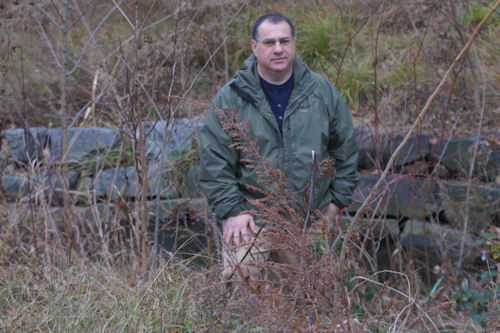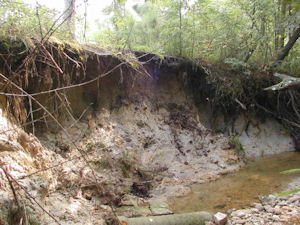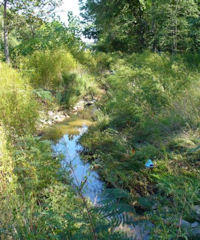Rather than make developers install stormwater-control projects of marginal value, Henrico County pools resources to fund high-impact stream reclamations.
by James A. Bacon
Near the Henrico County government training center, a five-foot pipe spills water into Rocky Branch, a forlorn and forgotten urban creek. When it rains, water from more than 80 acres of roofs and parking lots along Broad Street rushes through the culvert and shoots into the stream at high velocity. Over the years water had scoured the stream bank, creating a gully that cut as deep as 10 feet. Stormwater washed tons of sediment every year into the James River watershed, carrying phosphorous, nitrogen and other pollutants with it.
Thanks to a $600,000 stream restoration project, the ugly little gully has been stabilized. It hasn’t regained a pristine state of nature — some of its banks are hardened with large stones, logs and skeins of artificially implanted tree roots — but it isn’t eroding anymore. Thick with indigenous grass, shrubs and saplings, the banks are returning to woodland. Within a few years, the hand of man will be nearly invisible to passersby on the jogging trail just a few yards away.
Chalk up one small victory in the arduous campaign to clean up the James River and the Chesapeake Bay.
Rocky Branch is one of 48 stream segments that Henrico County identified more than 10 years ago as severely degraded and in need of restoration. To date, the county has repaired two others, one running through the Jamestown Townhouses apartment complex and the other behind Skipwith Elementary School.
None of the severely eroded creek beds would have been patched at all had Henrico County not adopted an innovative approach to storm water management. With the imposition of clean-water regulations under the Chesapeake Bay Preservation Act, Henrico required commercial and residential real estate developers to adopt Best Management Practices (BMPs) for controlling storm water run-off. What county officials found, however, was that some BMPs were cost-effective while others were not, explains Jeff W. Perry, engineering & environmental services division manager.
While two-thirds of the BMP projects were effective, removing 85% of the pollutant load, one third, usually associated with smaller subdivisions, accomplished little, eliminating only 11%. Developers would spend $30,000 to $40,000 for a project that might remove a half pound of phosphorous a year yet the water would run into a severely eroded creek or stream where literally tons of sediment, along with phosphorous and other regulated nutrients, washed into the watershed. Says Perry of the mis-allocation of resources: “It’s a real head scratcher.”
The county’s policy innovation was to take the money that developers would have spent on marginally useful BMPs and put it into a special environmental fund. That fund then would pay for the clean-up of streams like Rocky Branch where the environmental benefit would far outweigh that of neighborhood BMPs. “You’ve got X amount of resources,” Perry says. “Why not get the biggest bang for the buck?”
Joe Lerch, director of environmental quality for the Virginia Municipal League, embraces Perry’s logic. By combining the contributions of multiple developers, he says, the county can accomplish far more than individual property owners could on their own. The program has won national recognition. Here in Virginia, Fairfax County has put a similar system into place.
In 1999-2000, Henrico County had hired consultants to walk some 200 miles of creeks and streams across the 234-square mile locality. They documented stream conditions and identified segments that called for restoration. County officials then prioritized those stream segments for remediation, taking into account accessibility, elevation, the number of property owners whose cooperation was necessary and the number of gas and water lines that intersected the stream. Read more.






